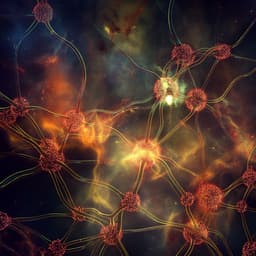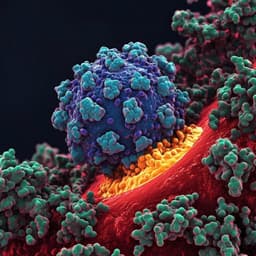
Medicine and Health
Simplifying glycan monitoring of complex antigens such as the SARS-CoV-2 spike to accelerate vaccine development
J. Sauvageau, I. Koyuturk, et al.
A groundbreaking study by authors including Janelle Sauvageau and Izel Koyuturk introduces a rapid and robust method for monitoring glycosylation in protein therapeutics. Leveraging HPAEC-PAD technology, this research presents an exciting alternative for ensuring the quality of complex biotherapeutics, particularly in the context of SARS-CoV-2 spike protein production.
~3 min • Beginner • English
Introduction
The study addresses the challenge of monitoring complex glycosylation on highly glycosylated vaccine antigens such as the SARS-CoV-2 spike protein, which has up to 22 N-glycosylation sites per protomer. Traditional methods like HILIC-Fld profiling of released glycans and LC-MS glycopeptide analysis are powerful but become cumbersome, time-consuming, and difficult to interpret for proteins with many glycosites. Given the need to accelerate vaccine development for future pandemics, the authors propose evaluating high-performance anion-exchange chromatography with pulsed amperometric detection (HPAEC-PAD) monosaccharide analysis as a rapid, robust alternative for batch-to-batch glycosylation monitoring. The goal is to determine whether HPAEC-PAD can sensitively detect both major and minor glycosylation differences and whether results correlate with established methods.
Literature Review
The paper reviews that glycosylation impacts key attributes like stability, efficacy, and immunogenicity for protein therapeutics and vaccines. It cites examples where glycan changes (e.g., removal of high-mannose or sialylation) altered immunogenicity of spike and influenza antigens. Regulatory guidance underscores the need to monitor glycosylation. Established analytical methods include HILIC-Fld of released, labeled N-glycans and LC-MS of glycopeptides, which are suitable for simpler glycoproteins (e.g., mAbs) but become complex for antigens like SARS-CoV-2 spike due to extensive microheterogeneity. Historically, HPAEC-PAD monosaccharide analysis saw limited use due to concerns about robustness and lack of glycan structure identification, but technological improvements (e.g., disposable electrodes, calibration curve normalization) have addressed many issues. HPAEC-PAD can quantify neutral and acidic monosaccharides without labeling and has sensitivity advantages over some alternatives and can detect certain modified sugars (e.g., mannose-6-phosphate).
Methodology
Two cohorts of SARS-CoV-2 spike proteins were analyzed. Cohort 1 comprised five glycovariants produced in engineered CHO cell lines: FUT8 knockout (F15; afucosylated), ST3GAL4 knockout (S9; reduced α2,3 sialylation), FUT8/ST3GAL4 double knockout (dKO2), wild-type CHO55E1, and wild-type CHO55E1 cultured with kifunensine (producing predominantly high-mannose glycans). Cohort 2 comprised three independent production batches (PRO1-392, PRO1-394, PRO1-412) from the same stable CHO pool intended to represent minor lot-to-lot glycosylation differences.
Analytical workflow:
- HPAEC-PAD monosaccharide analysis: Neutral sugars (Fuc, GalNAc as GalN after deacetylation, GlcNAc as GlcN after deacetylation, Gal, Glc, Man) quantified after TFA hydrolysis (5 M TFA, 100 °C, 2 h), drying, reconstitution, and triplicate injections on a Dionex ICS-6000 with CarboPac PA20 columns and NaOH gradients. Acidic sugars (Neu5Ac, Neu5Gc) quantified after Sialidase A digestion (37 °C, 18 h) and separation with NaOH/sodium acetate gradients. Data acquisition in Chromeleon and analysis in GraphPad Prism.
- HILIC-UPLC-Fld of released N-glycans: PNGase F release (Rapid PNGase F), cleanup, 2-AB labeling, desalting, optional sialidase treatment to identify sialylated peaks, separation on Waters BEH amide column with ammonium formate/acetonitrile gradient, GU calibration with labeled dextran ladder, and tentative assignments via GlycoBase. Complex traces served as non-quantitative fingerprints except for identifiable major peaks.
- LC-MS glycopeptide analysis: Bottom-up digestion with four proteases (trypsin, chymotrypsin, α-lytic protease, Glu-C) to isolate single-glycosite peptides; parallel deglycosylated controls with PNGase F for peptide confirmation. NanoLC on C18 with Orbitrap Eclipse detection; HCD-MS/MS with dynamic exclusion. Manual validation of glycopeptides and processing with in-house GlycoPIQ v2.1 to identify glycan categories and relative abundances per site. Glycopeptides covering two or more glycosites were excluded.
Protein production: Ancestral SARS-CoV-2 spike ectodomain (Wuhan) cloned in pTT5 and expressed transiently in glycoengineered CHO lines or stably in pools. Culture conditions, transfection parameters (PEI-Max), kifunensine treatment where indicated, and affinity purification (AVIPure-COV2S) with buffer exchange and characterization (SDS-PAGE, spectrophotometry) are described.
Key Findings
- HPAEC-PAD neutral sugars (engineered CHO glycovariants): WT spike (PRO1-471) hydrolysates contained Fuc, Gal, Man, and GlcN, consistent with complex N-glycans. ST3GAL4 KO variants (PRO1-469, PRO1-470) showed ~27–29% lower Gal (~10 mol/mol decrease) relative to WT. Fuc was undetectable in FUT8 KO variants (PRO1-468, PRO1-470), indicating complete afucosylation. Kifunensine-treated spike (PRO1-472) displayed markedly elevated Man and GlcN; Man was 2.6-fold higher than WT, consistent with high-mannose enrichment. GalN (from GalNAc) was not detected, suggesting absent or below-detection O-glycans.
- HPAEC-PAD sialic acids: WT (PRO1-471) had 21.2 mol Neu5Ac per mol protein; FUT8 KO (PRO1-468) had 26.7; ST3GAL4 KOs (PRO1-469, PRO1-470) had low Neu5Ac (2.0 and 2.1); kifunensine (PRO1-472) had 1.3. Trace Neu5Gc (~0.1 mol/mol) detected across most samples.
- HILIC-Fld: Complex glycan fingerprints for all except kifunensine sample, which showed only Man4–9 (Man9 most abundant). Signals at high GU values indicated sialylation in WT and FUT8 KO but were absent in ST3GAL4 KOs and kifunensine. Fucosylated biantennary FA2/FA2G1/FA2G2 prominent in sialylated variants; afucosylated A2/A2G1/A2G2 prominent in FUT8 KOs. After desialylation, WT displayed higher FA2G2 than FA2, whereas ST3GAL4 KO showed the opposite, consistent with lower galactosylation in KO.
- LC-MS glycopeptides: Confident assignments obtained for 21/22 N-glycosites (N1134 not consistently detected). WT aligned with literature: high-mannose predominant at N234 and present at N61 and N717; other sites mainly complex-type, with tri- and tetra-antennary glycans more prevalent near the C-terminus. Sialylation was minimal in ST3GAL4 KOs and present at multiple sites in WT and FUT8 KO, higher in FUT8 KO (PRO1-468) alongside more tetra-antennary glycans. Fucosylated glycans were absent in FUT8 KOs and kifunensine samples; fucosylation predominated in complex glycans of WT and ST3GAL4 KO except partial afucosylation at N1098. Kifunensine sample had high-mannose only (Man9 predominant).
- Cross-assay concordance: Increased Neu5Ac in PRO1-468 vs WT by HPAEC-PAD mirrored LC-MS sialylation and HILIC-Fld trends; higher antennae number by LC-MS corresponded to higher GlcN by HPAEC-PAD.
- Batch-to-batch comparison (same CHO pool): HPAEC-PAD detected higher GlcN and Gal in PRO1-392 vs PRO1-394 and PRO1-412, and significantly higher Neu5Ac (16.5 vs 10.8 and 8.7 mol/mol). HILIC-Fld showed PRO1-392 had lower Man5 (5.7% vs 14.0% and 11.8%) and higher FA2G2S1 (16.6% dominant peak), indicating higher sialylation and complex branching. LC-MS corroborated higher sialylation/galactosylation and more tri-/tetra-antennary glycans in PRO1-392 and lower high-mannose contribution. Process data suggested earlier harvest and higher viability aligned with higher sialylation in PRO1-392.
Overall: HPAEC-PAD rapidly and reproducibly detected both major (engineered glycoform) and minor (lot-to-lot) glycosylation differences that agreed with HILIC-Fld and LC-MS findings.
Discussion
The findings demonstrate that HPAEC-PAD monosaccharide analysis offers a rapid, robust means to monitor glycosylation changes in highly glycosylated antigens where conventional methods face practical limitations. HILIC-Fld on released glycans becomes difficult to interpret for complex profiles due to peak overlap and limited standards, and LC-MS glycopeptide analysis, while site-specific and comprehensive, is slow and generates complex datasets that impede straightforward lot comparisons. HPAEC-PAD provided simple, quantitative readouts of key monosaccharides (e.g., Neu5Ac, Fuc, Gal, Man, GlcNAc as GlcN) that captured biologically and process-relevant shifts such as afucosylation in FUT8 KOs, reduced galactosylation and sialylation in ST3GAL4 KOs, high-mannose enrichment under kifunensine, and subtle lot-to-lot differences in branching and sialylation. These measurements correlated closely with trends detected by HILIC-Fld and LC-MS, indicating that global monosaccharide composition effectively reflects underlying glycan population shifts. Given its speed, minimal sample preparation, and ease of interpretation, HPAEC-PAD is well-suited for routine batch monitoring and could support accelerated development timelines and QC for complex glycoprotein antigens.
Conclusion
HPAEC-PAD monosaccharide assays can effectively monitor batch-to-batch glycosylation differences in the SARS-CoV-2 spike protein and yield results that align with HILIC-Fld and LC-MS analyses. The approach is fast, quantitative, reproducible, and easier to implement and interpret than traditional glycomics assays for highly complex targets, making it attractive for QC and rapid process development. While HILIC-Fld and LC-MS remain essential for in-depth structural and site-specific characterization, strategic use of monosaccharide analysis can accelerate vaccine antigen development and improve preparedness for future pandemics. Future work could extend validation to other complex antigens, assess detection of additional modified monosaccharides (e.g., sulfation), and further standardize workflows for regulatory adoption.
Limitations
Monosaccharide analysis does not provide glycan structural identities or site-specific information; it yields average composition, which can mask specific distribution changes (e.g., mannose content changes when high-mannose decreases but complex glycans increase). Detection of O-glycans was below the assay’s sensitivity in this study (no GalN detected after TFA hydrolysis). Although HPAEC-PAD has improved robustness, it historically faced concerns about electrode fouling and response variability; calibration and disposable electrodes mitigate but do not eliminate these risks. LC-MS coverage was incomplete for some sites (e.g., N1134; and in batch analysis N709 and N1134), reflecting inherent analytical limitations. Potential detection of certain modifications (e.g., sulfation) by HPAEC-PAD is uncertain. HILIC-Fld peak identifications were limited due to complexity and lack of standards, yielding largely qualitative fingerprints.
Related Publications
Explore these studies to deepen your understanding of the subject.







